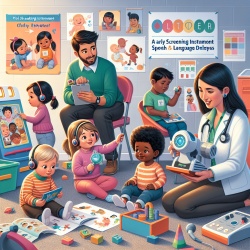Understanding the nuances of speech perception is crucial for practitioners providing online therapy services to schools. The research article "Changes in Click Migration as a Function of Age: Implications for the Development of Speech Perception" by Michael R. Seitz and Robin Springer-Bloom offers valuable insights into how speech perception evolves with age. This blog post will explore key findings from the study and provide practical tips for implementing these insights into your therapy sessions.
Key Findings from the Research
The study aimed to determine the ability of children of various ages to perform a click location task and analyze the click migration patterns. Here are some significant findings:
- All age groups were able to successfully perform the click location task.
- There were unexpected differences in the amount of click migration as a function of age.
- Accuracy of sentence repetition and click location improved with age.
- Click migration patterns varied, with older groups showing more restricted migration.
Practical Applications for Practitioners
Based on these findings, practitioners can enhance their therapy sessions by considering the following strategies:
- Age-Appropriate Tasks: Tailor the complexity of tasks according to the age and cognitive development of the child. Younger children may need simpler tasks to accurately perceive and locate clicks.
- Focus on Sentence Repetition: Incorporate exercises that improve sentence repetition skills. As the study shows, accuracy in sentence repetition correlates with better click location.
- Monitor Click Migration: Observe and document click migration patterns to understand the child's perceptual processing. This can help in customizing interventions that target specific perceptual skills.
- Use of Breaks: Integrate major constituent breaks in speech exercises to help children better perceive and locate clicks. This can enhance their overall speech perception abilities.
Encouraging Further Research
The study opens up several avenues for further research. Practitioners are encouraged to explore the following areas:
- Investigate the impact of different response requirements on click location accuracy.
- Examine the role of linguistic development in click migration patterns among children with language disorders.
- Explore the effectiveness of click location techniques in diverse linguistic and cultural settings.
By staying informed about the latest research and incorporating evidence-based practices, practitioners can significantly enhance their therapeutic interventions, leading to better outcomes for children.
To read the original research paper, please follow this link: Changes in Click Migration as a Function of Age: Implications for the Development of Speech Perception.










